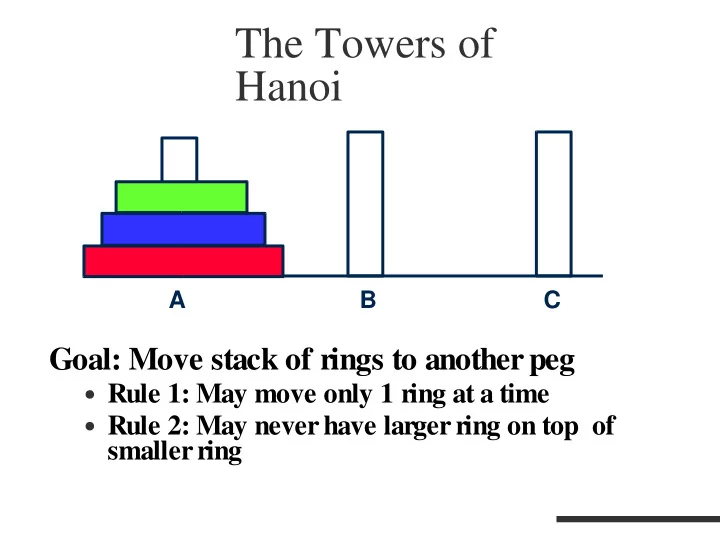

The Towers of Hanoi A B C Goal: Move stack of rings to another peg ● Rule 1: May move only 1 ring at a time ● Rule 2: May never have larger ring on top of smaller ring
Recursive Towers of Hanoi public void toh(int n, char from, char inter, char to) { if (n == 1) System.out.println(“disk 1 from “ + from + ” to “ + to); else { toh(n-1, from, to, inter); // from->inter System.out.println(“disk “ + n + “ from “ + from + “ to “ + to); toh(n-1, inter, from, to); // inter->to } }
Towers of Hanoi - Complexity ● For 1 rings we have 1 operation. ● For 2 rings we have 3 operations. ● For 3 rings we have 7 operations. ● For 4 rings we have 15 operations. ● In general, the cost is 2 n − 1 = O 2 n ● Each time we increment n , we double the amount of work. ● This grows incredibly fast!
The Wise Peasant’s Pay Day(n) Pieces of Grain 1 2 2 4 3 8 2 N 4 16 ... 63 9,223,000,000,000,000,000 64 18,450,000,000,000,000,000
How Bad is 2 n ? ● Imagine being able to grow a billion (1,000,000,000) pieces of grain a second… ● It would take ● 585 years to grow enough grain just for the 64 th day ● Over a thousand years to fulfill the peasant’s request !
It can get worse ● Ackerman's function ● public long ack(m,n) { if (m==0) return n+1; if (n==0) return ack(m-1,1); return ack(m-1, ack(m, n-1)); } ● ack(3, 65553) = 2^65553-3 ● ack(4,2) is greater than the number of particles in the universe
Divide-and-Conquer ● Recall the recursive binary search. ● It divides a big problem into two smaller parts and solves each one separately. ● Subdivision keeps going in each half until solution is reached. ● Divide-and-Conquer is a prime candidate for a recursive method using two recursive calls.
Mergesort ● Yet another sorting algorithm! ● More efficient than any of the sorting algorithms seen so far. ● The idea is to divide and conquer: divide the array in half, sort each independently, then merge the two already sorted arrays. ● All the work is in merging.
Recursive Mergesort public void mergesort(long[] result, int lower, int upper) { if (lower == upper) return; else { int mid = (lower+upper)/2; // sort lower half mergesort(result, lower, mid) // sort upper half mergesort(result, mid+1, upper); // merge merge(result, lower, mid+1, upper); }
Merge public void merge(long[] a, int low, int high, int highend) { int i=0, lowstart=low,lowend=high-1; int mid=high-1; while (low<=lowend && high<=highend) if theArray[low] < theArray[high] a[i++] = theArray[low++]; else a[i++] = theArray[high++]; while (low<=mid) // if high ended a[i++] = theArray[low++]; while (high <= highend) // if low ended a[i++] = theArray[high++]; for(i=0; i<highend-lowstart+1; i++) theArray[lowstart+i] = a[i]; }
Mergesort Efficiency ● Number of copies ● There are log (n) number of sorting levels ● At each level there are n copies ● Total nlog(n) ● Number of comparisons for each merge ● worse case: 1 less than the number of copies ● best case: half of the number of copies ● Mergesort is nlog(n)
Recommend
More recommend